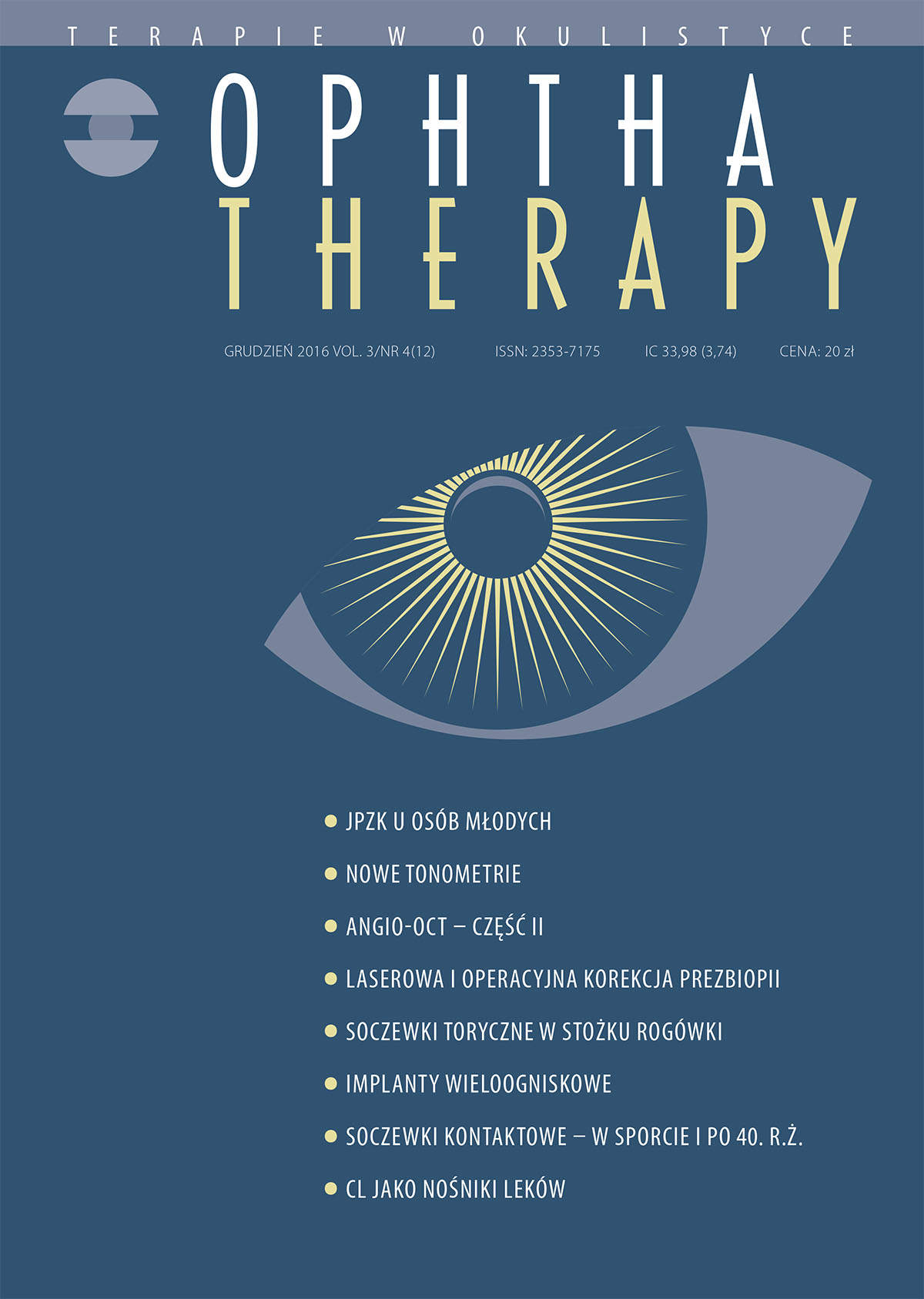Jaskra pierwotnie zamkniętego kąta u osób młodych
##plugins.themes.bootstrap3.article.main##
Abstrakt
Rozpoznanie pierwotnie zamkniętego kąta i jaskry pierwotnie zamkniętego kąta u osób młodych oparte jest na wyniku obrazowania struktur przedniego odcinka przy użyciu koherentnej tomografii optycznej. Zabiegowa korekta stanu anatomicznego, przede wszystkim laserowa, zależy od typu pierwotnie zamkniętego kąta i mechanizmu jego zamknięcia. U młodzieży z czystą formą konfiguracji płaskiej tęczówki jest to typ II. Typ III to kombinacja konfiguracji plateau iris z blokiem źrenicznym powstałym w wyniku skurczu akomodacji i/lub wzrostu soczewki u osób 40–50-letnich. Opis przypadków wprowadza w zasady postępowania mającego na celu otwarcie naturalnej drogi odpływu.
Pobrania
##plugins.themes.bootstrap3.article.details##

Utwór dostępny jest na licencji Creative Commons Uznanie autorstwa – Użycie niekomercyjne – Bez utworów zależnych 4.0 Międzynarodowe.
Copyright: © Medical Education sp. z o.o. License allowing third parties to copy and redistribute the material in any medium or format and to remix, transform, and build upon the material, provided the original work is properly cited and states its license.
Address reprint requests to: Medical Education, Marcin Kuźma (marcin.kuzma@mededu.pl)
Bibliografia
2. Radhakrishnan S, Rollins AM, Roth JE et al. Real-time optical coherence tomography of the anterior segment at 1310 nm. Arch Ophthalmol. 2001; 119: 1179-85.
3. Radhakrishnan S, Goldschmith J, Huang D et al. Comparison of optical coherence tomography and ultrasound biomicroscopy for detection of narrow anterior chamber angles. Arch Ophthalmol. 2005; 123(8): 1053-9.
4. Baskaran M, Iyer JV, Narayanaswamy A et al. Anterior segment imagining predicts incident gonioscopic angle closure. Ophthalmology. 2015; 122: 2380-4.
5. Kessin SV, Thygesen J. Primary angle-closure and angle-closure glaucoma. Kugler Publications, Amsterdam 2007: 49-53.
6. Ritch R. Plateau iris is caused by abnormally positioned ciliary processes. J Glaucoma. 1992; 1: 23-6.
7. Niżankowska MH. Jaskra pierwotnie zamkniętego kąta. Diagnostyka, zapobieganie, leczenie. Elsevier Urban & Partner, Wrocław 2012: 11-14.
8. Ritch R, Tham CCY, Lam DSC. Obwodowa plastyka laserem argonowym. In: Chen TC. Chirurgia jaskry. (Red. wyd. polskiego: Niżankowska MH). Elsevier Urban & Partner, Wrocław 2008: 281-7.
9. Ritch R, Tham CC, Lam DS. Long-term success of argon laser iridoplasty in the management of plateau iris syndrome. Ophthalmology. 2004; 111: 104-8.
10. Lam DS, Lai JS, Tham CC et al. Argon laser peripheral iridoplasty versus conventional systemic medical therapy in treatment of acute primary angle-closure glaucoma: a prospective, randomized, controlled trial. Ophthalmology. 2002; 109: 1591-6.
11. Narayanaswamy A, Baskaran M, Perera SA et al. Argon laser peripheral iridoplasty for primary angle-closure glaucoma. A randomized controlled trial. Ophthalmology. 2016; 123: 514-21.
12. Fundamentals and principles of ophthalmology. Chapter 2. AAO Basic and clinical science course 2005-2006: 67-76.
13. Lee Y, Sung KR, Sun JH. Dynamic changes in anterior segment (AS) parameters i eyes with primary angle closure (PAC) and PAC glaucoma and open-angle eyes assessed using AS optical coherence tomography. Invest Ophthalmol Vis Sci. 2012; 53: 693-7.
14. Yan PS, Lin HT, Wang QL et al. Anterior segment variations with age and accomodation demonstrated by slit lamp-adapted optical coherence tomography. Ophthalmology. 2010; 117: 2301-7.
15. Acton J, Calmon JF, Scholtz R. Extracapsular cataract extraction with posteriori chamber lens implantation in primary angle closure glaucoma. J Cataract Refract Surg. 1997; 23: 930-4.
16. Gunning FP, Greve EL. Lens extraction for uncontrolled angle-closure glaucoms: long-term follow-up. J Cataract Refract Surg. 1998; 24: 1347-56.
17. Hayashi K, Hayashi H, Nakao F et al. Changes in anterior chamber angle width and depth after intraocular lens implantation in eyes with glaucoma. Ophthalmology. 2000; 107: 698-703.
18. Jacobi PC, Dietlein TS, Luke C et al. Primary phacoemulsufication and intraocular lens implantation for acute angle closure glaucoma. Ophthalmology. 2002; 109: 1597-603.
19. Nolan W. Lens extraction in primary angle closure. Editorial Brit J Ophthalmol 2006; 90: 1-2.
20. Hata H, Yamane S, Hata S et al. Preliminary outcomes of primary phacoemulsification plus intraocular lens implantation for primary angle-closure glaucoma. J Med Invest. 2008; 55: 287-91.
21. Keenan TDL, Salmon JF, Yeates D et al. Trendes in rates of primary angle closure glaucoma and cataract surgery in England from 1968 to 2004. J Glaucoma. 2009; 18: 201-5.
22. Dooley I, Charamlampidou S, Malik A et al. Changes in intraocular pressure and anterior segment morphometry after uneventful phacoemulsification cataract surgery. Eye. 2010; 24: 519-26.
23. Tham CC, Kwong YY, Leung DY et al. Phacoemulsification versus combined phacotrabeculectomy in medically uncontrolled chronic angle closure glaucoma with cataract. Ophthalmology. 2009; 116: 725-31.
24. Tham CC, Kwong YY Leung DY et al. Phacoemulsification versus phacotrabeculectomy in chronic angle closure glaucoma with cataract complications. Arch Ophthalmol. 2010; 128: 303-11.
25. Sihota R, Ghate D, Mohan S et al. Study of biometric parameters in family members of primary angle closure patients. Eye. 2008; 22: 521-7.
26. Rong SS, Tang FY, Chu WK et al. Genetic association of primary angle-closure disease. A systematic review and meta-analysis. Ophthalmology. 2016; 123: 1211.
27. Niżankowska MH, Kaczmarek R. Wrocławskie dane epidemiologiczne jaskry. Adv Clin Exp Med. 2004; 13/5(supl. 2): 21-5.

